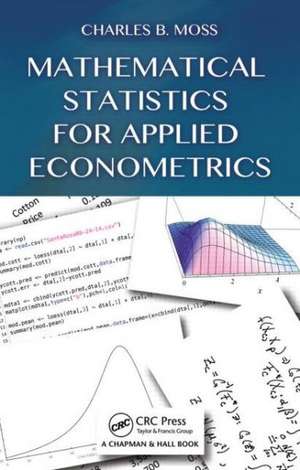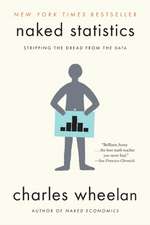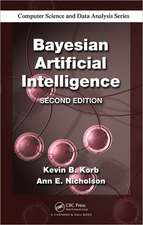Mathematical Statistics for Applied Econometrics
Autor Charles B. Mossen Limba Engleză Hardback – 16 oct 2014
Mathematical Statistics for Applied Econometrics covers the basics of statistical inference in support of a subsequent course on classical econometrics. The book shows students how mathematical statistics concepts form the basis of econometric formulations. It also helps them think about statistics as more than a toolbox of techniques.
Uses Computer Systems to Simplify Computation
The text explores the unifying themes involved in quantifying sample information to make inferences. After developing the necessary probability theory, it presents the concepts of estimation, such as convergence, point estimators, confidence intervals, and hypothesis tests. The text then shifts from a general development of mathematical statistics to focus on applications particularly popular in economics. It delves into matrix analysis, linear models, and nonlinear econometric techniques.
Students Understand the Reasons for the Results
Avoiding a cookbook approach to econometrics, this textbook develops students’ theoretical understanding of statistical tools and econometric applications. It provides them with the foundation for further econometric studies.
| Toate formatele și edițiile | Preț | Express |
|---|---|---|
| Paperback (1) | 310.51 lei 6-8 săpt. | |
| CRC Press – 14 oct 2024 | 310.51 lei 6-8 săpt. | |
| Hardback (1) | 789.57 lei 6-8 săpt. | |
| CRC Press – 16 oct 2014 | 789.57 lei 6-8 săpt. |
Preț: 789.57 lei
Preț vechi: 962.89 lei
-18% Nou
Puncte Express: 1184
Preț estimativ în valută:
151.10€ • 157.17$ • 124.74£
151.10€ • 157.17$ • 124.74£
Carte tipărită la comandă
Livrare economică 14-28 aprilie
Preluare comenzi: 021 569.72.76
Specificații
ISBN-13: 9781466594098
ISBN-10: 1466594098
Pagini: 368
Ilustrații: 54 black & white illustrations, 61 black & white tables
Dimensiuni: 156 x 234 x 23 mm
Greutate: 0.66 kg
Ediția:1
Editura: CRC Press
Colecția Chapman and Hall/CRC
Locul publicării:Boca Raton, United States
ISBN-10: 1466594098
Pagini: 368
Ilustrații: 54 black & white illustrations, 61 black & white tables
Dimensiuni: 156 x 234 x 23 mm
Greutate: 0.66 kg
Ediția:1
Editura: CRC Press
Colecția Chapman and Hall/CRC
Locul publicării:Boca Raton, United States
Cuprins
DEFINING RANDOM VARIABLES: Introduction to Statistics, Probability and Econometrics. Random Variables and Probability Distributions. Moments and Moment Generating Functions. Binomial and Normal Random Variables. ESTIMATION: Large Sample Theory. Point Estimation. Interval Estimation. Testing Hypothesis. ECONOMETRIC APPLICATIONS: Elements of Matrix Analysis. Regression Applications in Econometrics. Notes. Bibliography. Index.
Recenzii
"Its goals are to cover the basics of statistical inference in support of a subsequent econometrics course and to explain the ’why’ to motivate the students who had previously taken an introductory statistics or econometrics course of a cookbook ¿avour. Such a textbook is needed, as several popular econometrics textbooks put fundamentals of mathematical statistics in an appendix … [T]he book shows how mathematical statistics is useful in econometrics and economic decisions under uncertainty and risk. It carefully explains the logic underlying estimators and tests, with an emphasis on laying a solid foundation for their uses in the subsequent applications. It is very useful to introduce and use the symbolic programs Maxima and MathematicaTM for the mathematical calculations, in addition to the open source package R for the numerical and graphical tasks. The textbook also has web resources with lecture slides, data sets and computer programs … and can be used both by graduate students from economics, business and various other backgrounds and by instructors and practitioners as a reference."
—Shuangzhe Liu in Stastistical Papers, October 2016
"This book presents a useful and well-integrated connection between mathematical statistics and applied econometrics. There is a natural progression from probability theory to estimations to economics applications, and the examples are helpful to understand and illustrate the statistical concepts. I highly recommend it to students who want to understand statistical theory that is driving econometrics applications frequently used in economics research."
—Ani Katchova, Associate Professor, Agricultural Economics, University of Kentucky
"This book is a formal yet accessible introductory textbook to mathematical statistics, with a clear emphasis on building a strong background for the subsequent study of econometric methods employed in social sciences, agricultural economics, finance, and agribusiness. The book’s intended audiences are graduate students—very strong masters and all doctoral students—and professionals looking for an intuitive and easy-to use reference. The text is ideal for a one-semester or one-year course in mathematical statistics.
The book is a pleasure to read: it offers great perspectives through the use of ‘boxes’ that provide historical context and interesting facts. They represent a fun companion in the journey of learning the formal concepts of mathematical statistics throughout the book. In addition, the examples and applications are useful and intuitive, having in mind students in economics, agricultural economics, and business. The end-of-chapter exercises are adequate and do not go overboard."
—Alfonso Flores-Lagunes, Professor of Economics and Senior Research Associate, Center for Policy Research, Syracuse University, and Research Fellow, Institute for the Study of Labor (IZA)
—Shuangzhe Liu in Stastistical Papers, October 2016
"This book presents a useful and well-integrated connection between mathematical statistics and applied econometrics. There is a natural progression from probability theory to estimations to economics applications, and the examples are helpful to understand and illustrate the statistical concepts. I highly recommend it to students who want to understand statistical theory that is driving econometrics applications frequently used in economics research."
—Ani Katchova, Associate Professor, Agricultural Economics, University of Kentucky
"This book is a formal yet accessible introductory textbook to mathematical statistics, with a clear emphasis on building a strong background for the subsequent study of econometric methods employed in social sciences, agricultural economics, finance, and agribusiness. The book’s intended audiences are graduate students—very strong masters and all doctoral students—and professionals looking for an intuitive and easy-to use reference. The text is ideal for a one-semester or one-year course in mathematical statistics.
The book is a pleasure to read: it offers great perspectives through the use of ‘boxes’ that provide historical context and interesting facts. They represent a fun companion in the journey of learning the formal concepts of mathematical statistics throughout the book. In addition, the examples and applications are useful and intuitive, having in mind students in economics, agricultural economics, and business. The end-of-chapter exercises are adequate and do not go overboard."
—Alfonso Flores-Lagunes, Professor of Economics and Senior Research Associate, Center for Policy Research, Syracuse University, and Research Fellow, Institute for the Study of Labor (IZA)
Descriere
Avoiding a cookbook approach to econometrics, this textbook develops students’ theoretical understanding of statistical tools and econometric applications. It covers the basics of statistical inference in support of a subsequent course on classical econometrics. The book shows students how mathematical statistics concepts form the basis of econometric formulations and helps them think about statistics as more than a toolbox of techniques. Each chapter includes a summary, review questions, and numerical exercises.






